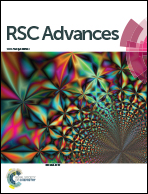Fabrication of recyclable superhydrophobic materials with self-cleaning and mechanically durable properties on various substrates by quartz sand and polyvinylchloride
Abstract
The recyclable superhydrophobic materials are successfully prepared by employing surface-functionalized quartz sand particles embedded into polyvinylchloride. The as-prepared superhydrophobic materials not only exhibited normal superhydrophobicity but also can retain excellent chemical stability and fascinating mechanical durability after many rigorous tests. These materials can pass the 5H pencil hardness test and maintain good superhydrophobicity even after 500 cm abrasion by a mechanical reciprocating abrasion test loaded of 500 g. Importantly, the debris that is scraped from the superhydrophobic materials can be recycled and easily reused to prepare the superhydrophobic materials. This method is suitable for large-scale production because it uses inexpensive and environmentally friendly materials and gets rids of sophisticated equipment, special atmospheres and harsh operation conditions. It's meaningful to a wide range of future applications in industry and real life.



 Please wait while we load your content...
Please wait while we load your content...